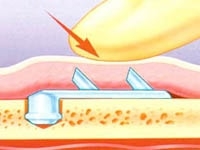Endotines are gradually gaining their special place among the methods of anti-aging facial correction, as they allow achieving effective results and are well combined with other procedures. These special retainers work in much the same way as surgical threads; they are also implanted into deep skin layers. Endotins show their advantage over other tissue fixatives in cases where it is necessary to avoid overstretching of tissues, tension of surgical sutures. In addition, endotines can significantly simplify certain surgical procedures that require tissue lifting and smoothing of deep wrinkles.
What Endotins Are Used for and Their Benefits
Endotins have been known to plastic surgeons for quite a long time, the technology of their application can hardly be called unique, since surgeons have in their arsenal a fairly wide range of various fixatives for tightening tissues – from threads to staples and screws. Nevertheless, endotines have gradually gained their niche in the arsenal of surgical techniques, since in some cases their use allows solving the patient's problem of facial rejuvenation more effectively than using other methods.
The essence of the work of endotins is as follows. These are very small plates with denticles, which are fixed to the bone tissue on one side, and firmly hold the stretched soft tissues on the other. Thanks to several teeth, endotine holds the stretched tissue firmly and evenly, grabbing it like a Velcro, while not allowing the cosmetic suture to tighten and thereby accelerate healing without the risk of scarring.
Endotins are made from biocompatible materials, which include polyglycolic, polylactic acids. After a few months, the endotines are completely absorbed and excreted from the body. This is their advantage over some other surgical fixators, which should be removed some time after plastic surgery, when the tightened tissues have grown together in the desired position.
Endotines are available in various shapes and sizes, which allows you to choose the optimal element for a specific task. The most effective use of endotins in the following cases:
- a heavy overhanging crease over the upper eyelid,
- deep nasolabial folds with loose, sagging skin,
- deep frontal wrinkles,
- drooping eyebrows.
Accordingly, it is possible to choose special forms of endotines, designed for fixing soft tissues in the area of the corners of the mouth and eyebrows, in the area of the eyelids and forehead, for lifting the middle zone of the face.
How endotins are installed and what effect they give
Installation of endotins is usually carried out during endoscopic surgery, anesthesia – most often general, but with small volumes of intervention it can be & nbsp; local. It is possible to use endotines as needed and during open facelift surgery.
 With the endoscopic method, skin incisions are made in the right places, soft tissues are exfoliated, endotin is strengthened on the bone tissue, then the exfoliated tissues are stretched over its teeth and fixed in a new position. All this is carried out under the control of the endoscope, which is removed after tissue fixation. Next the incision is closed with one or two cosmetic sutures.
With the endoscopic method, skin incisions are made in the right places, soft tissues are exfoliated, endotin is strengthened on the bone tissue, then the exfoliated tissues are stretched over its teeth and fixed in a new position. All this is carried out under the control of the endoscope, which is removed after tissue fixation. Next the incision is closed with one or two cosmetic sutures.
Depending on the extent of the surgical intervention, the patient goes home on the same day or a day later. The advantage of installing endotines is that the result of a facelift is visible almost immediately. But complete healing occurs in about two weeks.
The results of facial rejuvenation with the use of endotins are preserved for quite a long time, the period is calculated in years. But the patient must remember that many factors influence the durability of the effect: these are the individual characteristics of the organism, the lifestyle, and the implementation of the doctor's recommendations after the operation.







Add a comment